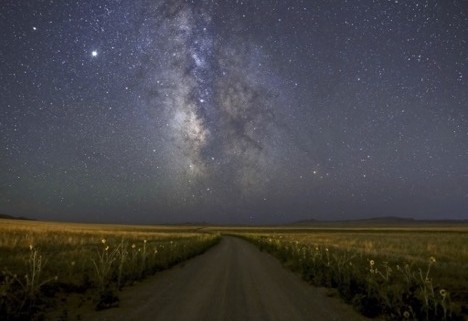Guest blog post: The Promise of a Dark Sky
by Bill Dunford
One of the first times I traveled mentally to the stars, it was Madeleine L’Engle who took me there. I was nine years old when I discovered that her skill allowed the flat pages of A Wrinkle in Time to take on a third dimension – then a fourth and a fifth – in order to transport me to Orion’s belt and points beyond.
The universe she showed me was not a safe one. But it was intriguingly complex, in constant motion, and shimmering with unexpected beauty.
I’m privileged to spend a lot of mental time in deep space as an adult as well. I work for the public engagement team at NASA’s Jet Propulsion Laboratory, where I help tell the stories of the robotic spacecraft that rove the surface of Mars and buzz by the moons of Jupiter.
But I also explore the sky on my own. I’m lucky enough to live near the salt flats and sagebrush seas of Utah, where the night skies are profoundly dark and brimming with stars. Not a few flecks of light like you might see in the suburbs, but a dizzying snowfall of stars. I venture deep into the desert to photograph the night sky, especially the Milky Way. Out there, you can really see it, stretching from horizon to horizon like a smoky column of vaporized diamonds. The camera sees even more, revealing a vibrant canvas of light, textures, and colors — a surprising number of colors. Electric blues, purples, reds.
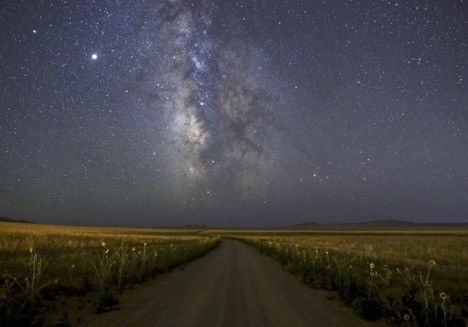
Saturn, Jupiter, the Milky Way — and Earth — as seen from the Cedar Mountain Wilderness Area in Utah. Photo by Bill Dunford
I can’t get enough of the night sky. It looks peaceful, but it is not still. It reels with unceasing motion, on time scales ranging from split seconds to eons. Meteors rain down continuously, tons of them per day, usually burning up in the blink of an eye. Watch the stars for even a few minutes against the horizon, and you can see that they’re moving. During the course of a night, the entire set of stars seems to wheel about in a great circle. Over the span of weeks, the planets can be seen wandering against the background constellations. Across centuries, the stars themselves change positions. Over the ages, they flower and die and new generations take their places.
A dark night sky dispels the illusion that the universe is somehow separate from us. That’s where you can see that the Earth is a planet, and that galaxies and comets and black holes are as much a part of Nature as a sunrise – which is nothing but a planet spinning to face its local star.
I was so pleased to learn that the seed of A Wrinkle in Time came more or less directly from the stars. In A Book, Too, Can Be a Star, the Story of Madeleine L’Engle and the Making of A Wrinkle in Time, the luminous new picture book biography by Charlotte Jones Voiklis and Jennifer Adams (full disclosure: Jennifer and I are married), we learn that “in a place called the Painted Desert, with its strange shapes and colors and its big skies scattered with stars, Madeleine had an idea for a new kind of book. It was inspired by sonnets and science and her sense of belonging when she looked at the night sky and listened to the stars sing.”
One of the ideas that most excites me is that this kind of interstellar inspiration is available to anyone, no telescope or camera required.
At least it used to be.
Due to the unceasing rise of light pollution, increasingly few places remain where city lights don’t dim the magnificence of the Milky Way. This map of artificial illumination, based on data from NASA and NOAA satellites, shows just how rare a dark sky has become.
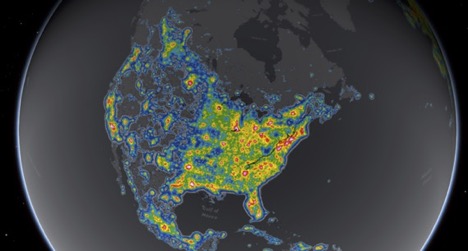
Credit: Falchi et al., Sci. Adv., Jakob Grothe/NPS contractor, Matthew Price/CIRES. More information at https://cires.colorado.edu/artificial-sky
Too much artificial light wastes energy and money, has negative effects on wildlife, and even impacts human health. And while it’s harder to quantify, there’s also the inspiration deficit factor. Too many people have never seen the Milky Way, their own galactic home, with their own eyes, or felt that connection to the natural world that sustains us.
There is good news: the spread of light pollution can be slowed, even rolled back. Doing so does not require draconian lifestyle changes. Steps as simple as replacing blaring, wasteful light fixtures with sensible, cost-saving lighting on homes and business can have a real impact on light levels in a community.
One example is Sun Valley, Idaho. Thanks to simple measures (notice the lamp directs the light down where it’s needed rather than into the sky) people can enjoy a sky that looks like this, near the center of town…in a parking lot.
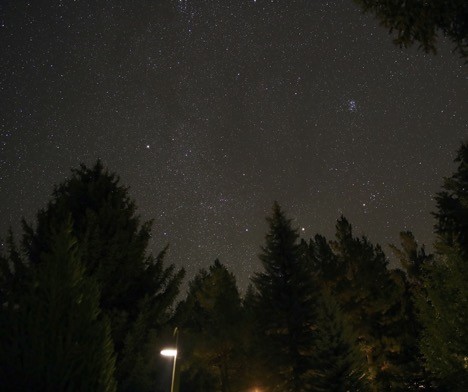
A parking lot not far from the town center in Sun Valley, Idaho. Look at all those stars! Reddish Mars makes an appearance just above the trees as well. Photo by Bill Dunford
A good place to learn about light pollution, and how effective its countermeasures can be, is darksky.org
We face bigger environmental challenges than light pollution, of course. Healing climate change and global poverty will require all the bravery, intelligence, anger, and love we can muster. But maybe starting with a directly solvable problem like restoring the night sky will show more and more people that protecting the natural world is necessary…and possible.
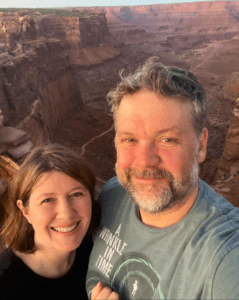
Bill Dunford (and Jennifer Adams)

